|
|
Updated as per James P. Tuttle's The Hawk Moths of North America, August 2, 2011
Updated as per BAMONA, August 2, 2011
Dedicated as per personal communication with Jean Robocker, Kalispell, May 25, 2015
Dedicated as per personal communication with Richard Kurth, Whitefish, May 31, 2018
|
Flathead County, Montana
Sphingidae
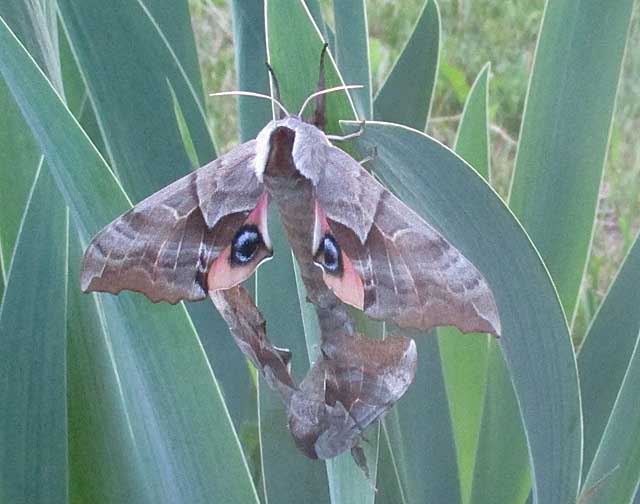
Smerinthus ophthalmica in copula, Kalispell, Flathead County, Montana,
May 24, 2015, courtesy of Jean Robocker.
This page is dedicated to Jean Robocker who provides the images of Smerinthus ophthalmica in copula, top and bottom of this page.
Prior to 2010 this moth would have been identified as the very similar Smerinthus cerisyi.
Schmidt & Anweiler (2010) put forth the argument, based on observations across a broad zone of contact of these moths in Alberta, and a 3.5% difference in the
sequence of the cox1 gene of their mitochondrial DNA, that ophthalmica deserves its own status as a distinct species.
Based on the many images of cerisyi and ophthalmica which have been sent to me over the years, I find the differences between the two species to be consistent.
I believe all three Smerinthus species listed in the thumbnail section occur in Montana, and probably in Flathead County.
Twelve Sphingidae species are listed for Montana on the BAMONA
checklist as of August 2, 2011. I have added some species to Montana which I feel are
likely present. Not all of the species are reported or anticipated in
Flathead County (One on BAMONA as of August 2, 2011; listed as Hemaris diffinis, but I think more likely Hemaris thetis).
It is hoped that this checklist, with the thumbnails and notes, will help you quickly identify the moths you have encountered.
A "WO" after the species name indicates that I have no confirmed reports of this species in your county, but I
(William Oehlke) expect that this moth is present or might be present. A BAM indicates the
moth is reported on the BAMONA website and/or in Moths of Western North America, #2. Distribution of Sphingidae of Western North America, revised,
an excellent little booklet available through Paul Opler.
Please help me develop this list with improved, documented accuracy by sending sightings (species, date, location), preferably with an
image, via email to Bill Oehlke.
Many thanks to Richard Kurth who sends the following image.
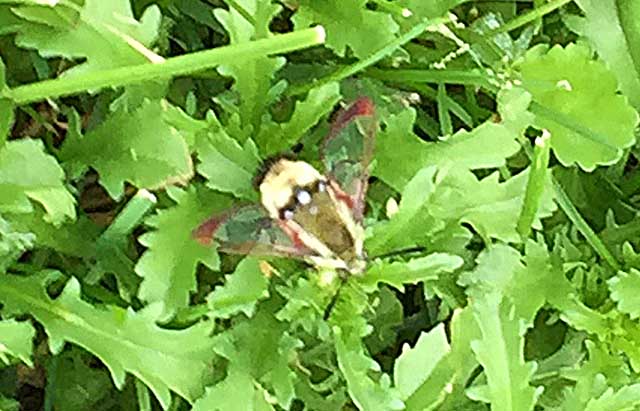
Hemaris thetis, Whitefish, Flathead County, Montana,
May 31, 2018, courtesy of Richard Kurth.
Visit Flathead County Sphingidae Larvae: Caterpillars; Hornworms
Visit Montana Catocala: Underwing Moths
Visit Sphingidae Checklists for all countries in North, Central and
South America
Sphinginae subfamily
Sphingini tribe:
 |
Sphinx chersis
WO??, but unlikely, Northern Ash Sphinx; Great Ash Sphinx: Soft dark gray to
blue-gray with a series of black dashes, one of which reaches the
wing tip. Ash, lilac, privet, cherry, quaking aspen. (generally more easterly)
|
 |
Sphinx drupiferarum larvae hide in the day and feed primarily on
cherry, plum, and apple at night.
|
 |
Sphinx luscitiosa WO?? , Canadian Sphinx; Clemen's Sphinx:
Yellowish gray in males and pale gray with a faint yellow tint in females. In both sexes, the dark
border on the outer margin widens as it approaches the inner margin. (generally more easterly)
|
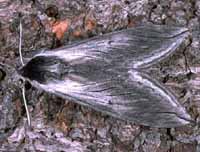 |
Sphinx perelegans WO, Elegant Sphinx:
Sphinx perelegans adults fly in montane woodlands and mixed chaparral-type vegetation as a single brood
in the north, with adults mainly on the wing in June and July.
It flies from dusk until after midnight. |
 |
If you have blueberries in the woods, then you probably have the
Poecila Sphinx. They are possibly in northern counties. |
 |
The upperside of the forewing has a narrow black subterminal line
bordered by a white inverted V-shaped line on the outside, and a
black line running inwards from the apex of the wing.
It is most often found in montane woodlands and along streamcourses. |
Smerinthini Tribe:
 |
Pachysphinx modesta
WO,
the Modest Sphinx or Poplar Sphinx,
This moth has a large, heavy body, and females
can be remarkably plump.
|
 |
Pachysphinx occidentalis WO?? , Big Poplar Sphinx:
This one is quite similar to Pachysphinx modesta, with modesta
being smaller and darker. There are two color forms: the upperside of the forewings is yellow brown in the pale form and dark gray in the dark form.
Lines and bands are well-defined. (generally more southerly)
|
 |
Paonias excaecata
WO, Blinded Sphinx:
The grey-blue eyespot of the hindwing gives this species its name.
Larvae feed on birches, willows, cherries and oaks.
The outer edge of the forewings is quite scalloped. |
 |
This small species is probably widespread and common. This species ranges across North America.
The hindwings have a small blue eyespot ringed with black on a yellow background.
|
 |
If you have willows and poplars nearby, you've probably got populations of
the Cerisyi's Sphinx. The hindwings are quite striking.
|
 |
Smerinthus jamaicensis closely resembles Smerinthus cerisyi, but jamaicensis is much smaller with larger blue patches on
more vibrant and deeper purple in the lower wings. possibly |
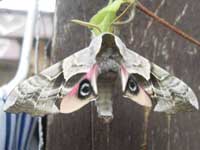 |
Smerinthus ophthalmica
JR: Larvae feed on poplars, aspen and willows.
Note different shape of double arced forewing pm line compared to the straighter pm line of cerisyi, directly above.
S. ophthalmica has smoother scalloping of the fw outer margin. The dark brown patch along the forewing inner margin
extends much further toward body in ophthalmica compared to cerisyi.
|
Smerinthus ophthalmica, Kalispell, May 24, 2015, Jean Robocker.
Macroglossinae subfamily
Dilophonotini tribe
 |
Hemaris diffinis BAMONA ( morelikley thetis),
Snowberry Clearwing; Bumblebee Moth:
The wings are basically clear, with dark brown to brownish-orange
veins, bases and edges. The thorax is golden-brown to dark
greenish-brown. The abdomen tends to be dark (black) with 1-2 yellow
segments just before the end. East of Continental Divide |
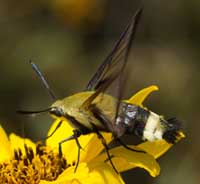 |
Hemaris thetis WO/RK, the Thetis Clearwing or Bee Hawk Moth,
The moth flies along forest edges and in meadows, gardens and
brushy fields. Day-flying adults nectar at lantana, dwarf bush honeysuckle,
snowberry, orange hawkweed, thistles, lilac, Canada violet, etc. West of Continental Divide.
|
Hemaris thetis, Whitefish, May 31, 2018, Richard Kurth
Macroglossini tribe
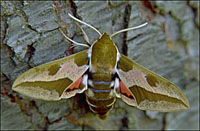 |
Hyles euphorbiae
WO, the Spurge Hawk Moth
The body is light brown with various white and dark brown
markings, while the wings have a conspicuous tan, brown, and pink or
red color pattern.
probably will expand there if not already present
|
 |
Hyles gallii WO,
the Bedstraw Hawk Moth or Gallium Sphinx
This species is not officially reported from your county; however, if
you have Gallium or Epilobium, you probably have
populations of this species. |
 |
Hyles lineata WO, the White-lined Sphinx
This species is very widespread. It can be seen flying during the day,
into the evening and also at night.
The highly variable larvae are often found in people's gardens. |
|
|
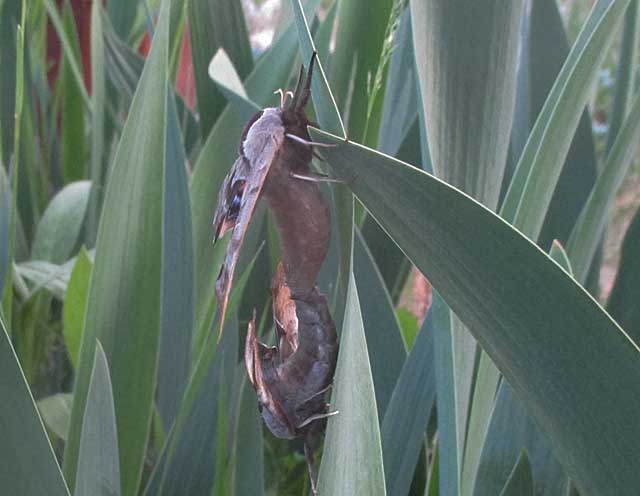
Smerinthus ophthalmica in copula, Kalispell, Flathead County, Montana,
May 24, 2015, courtesy of Jean Robocker.
Enjoy some of nature's wonderments, giant silk moth cocoons.
These cocoons are for sale winter and fall. Beautiful Saturniidae moths will emerge the following spring and summer.
Read Actias luna rearing article.
Additional online help available.
Eggs of many North American species are offered during the spring and summer. Occasionally
summer Actias luna and summer Antheraea polyphemus cocoons are available. Shipping to US destinations is done
from with in the US.
Use your browser "Back" button to return to the previous page.
This page is brought to you by Bill Oehlke and the
WLSS. Pages are on space rented from Bizland. If you would like to become a "Patron of the Sphingidae Site", contact Bill.
Please send sightings/images to Bill. I will do my best to respond to requests for identification help.
 | 
Show appreciation for this site by clicking on flashing butterfly to the left.
The link will take you to a page with links to many insect sites. |
This website has been created and is maintained by Bill Oehlke without government or institutional financial assistance. All expenses, ie., text reference
support material, webspace rental from Bizland, computer repairs/replacements, backups systems, software for image adjustments (Adobe Photoshop; L-View),
ftp software, anti-virus protection, scanner, etc. are my own.
I very much appreciate all the many images that have been sent to me, or of which I have been granted permission to copy and post from other websites.
All images on this site remain the property of respective photographers.
If you would like to contribute to the maintenance of this website by sending a contribution to
Bill Oehlke
Box 476
155 Peardon Road
Montague, Prince Edward Island, C0A1R0
Canada
your donation would be much appreciated and would be used for
1) paying for webspace rental;
2) paying for computer maintenance and software upgrades;
3) purchases of additional text reference material (journals and books) in anticipation of expanding the site to a worldwide Sphingidae site;
4) helping to pay my daughter's tuition (completed spring 2013); with anything left over going to humanitarian aid.
If you are mailing a check from USA, please use $0.85 postage ($1.15 is 2014 rate so check with post office first as rates are increasing). Donations can also be
made through Paypal via the button below.




